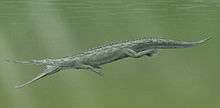Parasuchus
| Parasuchus Temporal range: Late Triassic, 222.5–212 Ma | |
|---|---|
 | |
| Scientific classification | |
| Kingdom: | Animalia |
| Phylum: | Chordata |
| Class: | Reptilia |
| Order: | Phytosauria |
| Genus: | †Parasuchus Lydekker, 1885 |
| Type species | |
| †Parasuchus hislopi Lydekker, 1885 | |
Parasuchus is an extinct genus of phytosaur known from the Late Triassic (late Carnian to early Norian stage) of Andhra Pradesh and Madhya Pradesh, India. It contains a single species, Parasuchus hislopi.[1][2]
Discovery
Parasuchus was first described on the basis of a chimeric material - a rhynchosaurian basicranium mixed with phytosaurian partial snout, scutes and some teeth. The partial premaxillary rostrum (snout), GSI H 20/11, was chosen as the lectotype of Parasuchus hislopi. GSI H 20/11 was collected from the Lower Maleri Formation (Pranhita–Godavari Basin), near the Maleri village of Adilabad district, Andhra Pradesh. Later, Sankar Chatterjee (1978) described many complete remains from the Lower Maleri Formation, as well as one nearly complete skull form the Tiki Formation, that he assignated to Parasuchus hislopi. Two complete and articulated skeletons that include complete skulls were collected in the vicinity of the Mutapyram village of Adilabad district. Both individuals were roughly 8 ft (2.4 m) in length, lying side by side. The left individual, ISI R 42, is perfectly preserved, and was designated as the neotype of the species following the suggestion of Chatterjee (2001). The rostrum of the right individual, ISI R 43, is the only missing part of its skeleton.[1] In the presumable gastric contents of these two skeletons, two articulated and almost complete skeletons of Malerisaurus robinsonae (both designated as ISIR 150), a basal archosauromorph, were found.[3] From the same locality as the neotype, three isolated conjoined basioccipital/basisphenoids (ISI R 45-47) were also recovered. A couple of miles north of that locality, near the Venkatapur village, two more excellently preserved skulls were found. ISI R 160 represents an isolated but nearly complete skull, while ISI R 161 represents partial skull and articulated postcranial remains.[1] Finally, the skull recovered from the Tikisuchus holotype site of the Tiki Formation (Gondwana Group),[4] about 4 miles west of Tiki village of Shadol District, Madhya Pradesh, is missing only the end of the snout and the squamosal. As the lectotype of the genus, it was found nearby Paradapedon remains.[1] Both formations date to the late Carnian to early Norian stage of the Late Triassic period, about 222.5-212 million years ago.[4][5]
Description
The name Parasuchus was first used by Thomas Henry Huxley (1870) in a faunal list. Since a diagnosis wasn't provided, it was considered to be a nomen nudum. Richard Lydekker (1885) described and named P. hislopi formally, and proposed the family name Parasuchidae. However, the species was based on a chimeric syntype material - a rhynchosaurian basicranium mixed with phytosaurian partial snout, scutes and some teeth. Friedrich von Huene (1940) identified the basicranium as belonging to Paradapedon huxleyi (now known as Hyperodapedon huxleyi), thus he assigned the phytosaurian material to a newly named species "aff." Brachysuchus maleriensis. Later, Edwin Harris Colbert (1958) designated all the Indian parasuchian material as Phytosaurus maleriensis. Gregory (1962) accepted this proposal. Sankar Chatterjee (1978), who described many complete remains of the Indian parasuchian, showed that it is not assignable either to Brachysuchus (which is closely related to or synonymous with Angistorhinus), or to Phytosaurus (a doubtful name, probably the senior synonym of Nicrosaurus). He noted that since the rhynchosaur basicranium is neither the holotype of P. hislopi, nor the lectotype of Paradapedon huxleyi, the suppression of P. hislopi should be avoided.[1] To avoid additional confusion, the nondiagnostic holotype of P. hislopi was replaced by a neotype (ISI R 42) with approval from the ICZN (Opinion 2045) following the application of Chatterjee (2001).[6]
The two articulated skeletons, ISI R 42-43, alone represent the most complete phytosaurs known to date. Additionally, Parasuchus has been found as one of the most primitive phytosaurs in phylogenetic analyses of Phytosauria, making it very significant for understanding the origin of the Phytosauria.[2] Some studies, like Chatterjee (1978) and Lucas et al. (2007), synonymized Parasuchus with another basal phytosaur, Paleorhynus. If this is the case, the name Parasuchus would have precedence over Paleorhynus because Paleorhynus was named in 1904, nineteen years after Parasuchus was named. However, detailed phylogenetic analyses of phytosaurs have not yet tested this proposal. The cladogram below follows Nesbitt (2011).[2]
| Archosauriformes |
| ||||||||||||||||||||||||||||||||||||||||||||||||||||||||||||||||||
| |
Etymology
Parasuchus was first described and named by Richard Lydekker in 1885 and the type species is Parasuchus hislopi. The generic name is derived from the Greek para/παρα meaning "beside" or "near" and suchus from the Greek souchos, which refers to the Egyptian crocodile-headed god Sobek. The specific name, hislopi, honors Hislop who drawn attention in 1854 to the red clays near Maleri village in which the holotype (and later the neotype and other specimens) of P. hislopi was recovered.[7]
References
- 1 2 3 4 5 Sankar Chatterjee (1978). "A primitive parasuchid (phytosaur) reptile from the Upper Triassic Maleri Formation of India" (PDF). Palaeontology. 21 (1): 83–127.
- 1 2 3 Sterling J. Nesbitt (2011). "The Early Evolution of Archosaurs: Relationships and the Origin of Major Clades" (PDF). Bulletin of the American Museum of Natural History. 352: 1–292. doi:10.1206/352.1.
- ↑ Sankar Chatterjee (1980). "Malerisaurus, A New Eosuchian Reptile from the Late Triassic of India". Philosophical Transactions of the Royal Society of London, Series B. 291: 163–200. doi:10.1098/rstb.1980.0131.
- 1 2 S. Chatterjee and P. K. Majumdar (1987). "Tikisuchus romeri, a new rauisuchid reptile from the Late Triassic of India". Journal of Paleontology. 61 (4): 787–793.
- ↑ Lucas, S. G. (1998). "Global Triassic tetrapod biostratigraphy and biochronology". Palaeogeography, Palaeoclimatology, Palaeoeocology. 143: 347–384. doi:10.1016/s0031-0182(98)00117-5.
- ↑ (Case 3165) (2003). "Parasuchus Hislopi Lydekker, 1885 (Reptilia, Archosauria): Lectotype Replaced By A Neotype" (PDF). Bulletin of Zoological Nomenclature. 60: 174–175.
- ↑ Richard Lydekker (1885). "Maleri and Denwa Reptilia and Amphibia". Palaeontology Indica. 1: 1–38.
